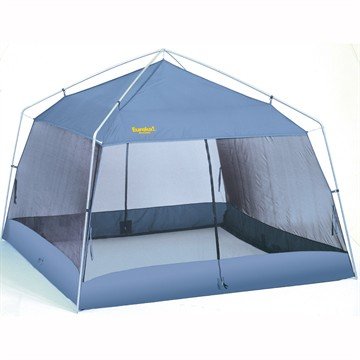Product Description
Aluminum frame is lightweight and easy to transport
| List Price: | $339.90 |
| Price: | $319.90 |
| as of Wed, 06 Mar 2013 13:40:27 GMT ***Remember, deals price on this item for sale just for limited time*** | |
Product Details
- Amazon Sales Rank: #226602 in Sports & Outdoors
- Size: N/A
- Color: Blue
- Brand: Eureka
- Model: 2626292
- Dimensions: 10.10" h x 10.90" w x 32.50" l, 21.10 pounds
Features
- Portable square screen house large enough to house standard-sized picnic table
- Measures 12' by 12'; full mesh panels
- Shock-corded, pre-bent, aluminum frame lighter than fiberglass
- Two full length doors zip completely open and out of the way
- Center height of 91 inches; weighs 19 pounds
Amazon.com
A great choice for backyard barbecues, days at the beach, or evenings lounging at the campsite, the square Eureka Breezeway is nicely light and easily transportable thanks to its aluminum frame. It has a 144 square foot area (12 by 12 feet)--just right to fit a standard-sized picnic table--and a roomy 7 foot, 7 inch center height. The near-vertical side walls also provide more usable interior space.
The 150D polyester splash cloth and roof provide excellent UV resistance, and offers more durability than other screen houses with 75D polyester roofs. The strong durable shockcorded aluminum frame attaches to the body by a central hub and clips for a fast and easy set up every time. Other features include two full-length doors and no-see-um polyester mesh walls.
About Eureka
Though the exact year is unknown, Eureka’s long history begins prior to 1895 in Binghamton, New York, where the company still resides today. Then known as the Eureka Tent & Awning Company, its first wares were canvas products--most notably, Conestoga wagon covers and horse blankets for nineteenth century American frontiersmen--as well as American flags, store awnings, and camping tents.
The company increased production of its custom canvas products locally throughout the 1930s and during the 1940 and even fabricated and erected the IBM "tent cities" just outside Binghamton. The seven acres of tents housed thousands of IBM salesmen during the company’s annual stockholders meeting, which had since outgrown its previous locale. In the 1940s, with the advent of World War II and the increased demand for hospital ward tents, Eureka expanded operations and began shipping tents worldwide. Ultimately, upon the post-war return of the GIs and the resultant housing shortage, Eureka turned its attention to the home front during the 1950s by supplying awnings for the multitude of mobile homes that were purchased.
In 1960, Eureka’s new and innovative Draw-Tite tent, with its practical, free standing external frame, was used in a Himalayan Expedition to Nepal by world renowned Sir Edmund Hillary, the first person documented to summit Mt. Everest only six years earlier. In 1963, Eureka made history during its own Mt. Everest ascent, with more than 60 of its tents sheltering participants from fierce 60+ mph winds and temperatures reaching below -20°F during the first all American Mt. Everest Expedition.
For backpackers and families, Eureka introduced its legendary Timberline tent in the 1970s. Truly the first StormShield design, this completely self-supporting and lightweight backpacking tent became one of the most popular tents the entire industry with sales reaching over 1 million by its ten year anniversary.
Eureka tents have also traveled as part of several historic expeditions, including the American Women’s Himalayan Expedition to Annapurna I in 1978 and the first Mt. Everest ascents by a Canadian and American woman in 1986 and 1988. In recent history, tents specially designed and donated by Eureka sheltered Eric Simonson and his team on two historic research expeditions to Mount Everest, this time in a quest for truth regarding the 1924 attempted summit of early English explorers George Mallory and Andrew Irvine. During the 1999 expedition, the team made history finding the remains of George Mallory, but the complete mystery remained unsolved. Returning in 2001 to search for more clues, the team found amazing historical artifacts which are now on display at the Smithsonian.



No comments:
Post a Comment